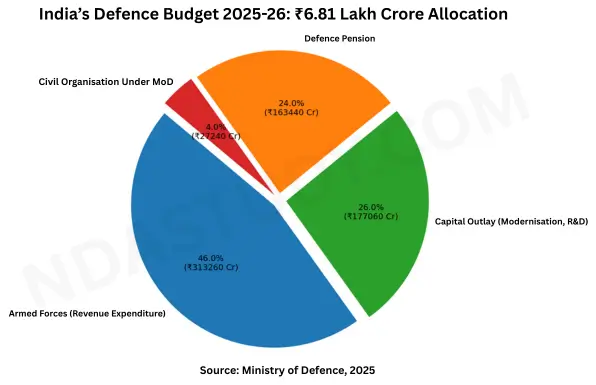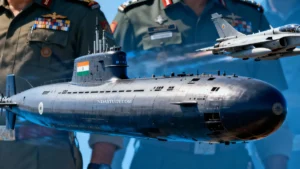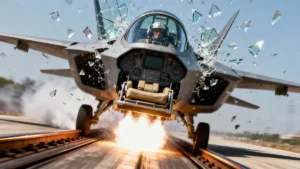India’s Defence Budget for 2025 has reached a record high of ₹6.81 lakh crore, reflecting a 9.53% increase compared to the previous year. This budget now accounts for nearly 2% of the nation’s GDP. The significant allocation occurs during a period of rising global security tensions and rapidly evolving strategic priorities for India. Therefore, this budget is not merely a financial statement; it represents a decisive step towards strengthening national security and modernising the armed forces.
In this article, we analyse the Indian Defence Budget for 2025, highlighting its main features and comparing it to past budgets. We discuss how increased military spending will impact modernisation, recruitment, and opportunities for young people, particularly those aspiring to join the National Defence Academy (NDA), CDS, UPSC Civil Services, etc.. Whether you are interested in defence, work in policy analysis, or dream of serving the nation, understanding the Indian Defence Budget 2025 is essential for grasping how India’s military investments shape the future of national security.
Key Points Summarised
- Have you heard? ₹1.8 lakh crore is set to modernise defence technology.
- Welfare and Support: Defence pensions and healthcare have seen significant increases, ensuring veterans and their families are well cared for.
- Youth Opportunities: Expanded recruitment, more NDA seats, and a push for tech-savvy talent are opening doors for India’s youth.
- Domestic Innovation: 75% of modernisation funds are reserved for Indian companies, fueling the ‘Atmanirbhar Bharat’ vision.
- Reforms: 2025 is declared the ‘Year of Reforms,’ with a focus on simplifying procurement, integrating new technologies, and fostering jointness among the services.
Defence Budget 2025 — Key Highlights and Allocations
The Indian Defence Budget for 2025 represents a significant move towards enhancing national security and reinforcing India’s role as a global defence player. As the world’s largest democracy encounters emerging security threats and rapidly advancing technologies, this budget highlights the necessity for increased military expenditure. It demonstrates India’s dedication to safeguarding its borders while also prioritising modernisation, self-reliance, and the empowerment of young individuals in the armed forces.
| Key Aspect | Indian Defence Budget 2025 Overview |
|---|
| Total Defence Budget 2025 | ₹6,81,210 crore (approx. $78.7 billion). This is a 9.5% increase from the previous year and represents about 13.5% of the total Union Budget. |
| Share of GDP | 1.91% of India’s estimated GDP for 2025-26. |
| Capital Outlay (Modernisation & Infra) | ₹1,80,000 crore (approx. $20.8 billion), 26.4% of the total budget, for new weapons, aircraft, warships, and infrastructure. 75% of this (₹1,11,545 crore) is earmarked for indigenous procurement. |
| Revenue Expenditure (Salaries & Ops) | ₹3,11,732 crore (approx. $36.1 billion), 45.8% of the budget, covering pay, allowances, and operational needs of the armed forces. |
| Defence Pensions | ₹1,60,795 crore (approx. $18.6 billion), 23.6% of the budget, supporting around 34 lakh pensioners. This is a 14% increase over last year. |
| Defence R&D (DRDO) | ₹26,817 crore (approx. $3.1 billion), a 12% increase, focusing on advanced technologies like AI, cyber, and robotics. |
| Indigenous Procurement | ₹1,12,000 crore (approx. $12.9 billion) set aside for domestic defence industry purchases, supporting ‘Aatmanirbhar Bharat’ (self-reliance). |
| Major Modernisation Focus | Investments in drones, deck-based aircraft, cyber warfare, and AI-driven technologies. Emphasis on jointness, integration, and new domains (cyber, space). |
| Civil Organisations under MoD | ₹28,683 crore (approx. $3.3 billion), 4.2% of the budget, for civil organisations under the Ministry of Defence. |
| Indian Coast Guard Capital Budget | 43% increase in allocation for the Indian Coast Guard’s capital expenditure. |
| Border Roads Organisation (BRO) | ₹7,146 crore (approx. $830 million) allocated for infrastructure development in border areas. |
| Year of Reforms | 2025-26 is declared the ‘Year of Reforms’ to simplify procurement, boost technology transfer, and enhance integration and jointness in the armed forces. |
| Historical Growth | Defence budget has more than tripled since 2014 (₹2.29 lakh crore in 2014 to ₹6.81 lakh crore in 2025). |
| Global Standing | India remains the world’s third-largest military spender and maintains the second-largest armed forces globally. |
| Strategic Impact | The budget aims to modernise forces, strengthen border infrastructure, and enhance India’s self-reliance and technological edge in defence, directly shaping national security. |
Note: The data is collected & delivered exclusively by the NDA Study from authentic news sites, government official websites, and the official documents of the Indian Defence Budget 2025, released for the financial year 2025-26.
Allocation of Defence Budget
India’s Defence Budget for 2025 has set a record at ₹6.81 lakh crore, a 9.53% increase from last year, now representing nearly 2% of the nation’s GDP. This substantial allocation addresses rising global security tensions and reflects India’s evolving strategic priorities. The budget emphasises modernisation and advanced technology, with a notable portion dedicated to capital expenditure for indigenous manufacturing. This focus not only enhances military capabilities but also fosters innovation and job creation. As India confronts new security challenges, this budget underscores a commitment to resilience, readiness, and self-reliance, providing opportunities for youth and defence aspirants.

Where the Money Goes: Detailed Breakdown of Indian Defence Budget 2025
India’s Defence Budget for 2025-26 has reached a record ₹6,81,210 crore (approximately USD 78 billion), which represents a significant 9.5% increase from last year. But how is this substantial amount allocated to ensure national security and prepare the armed forces for the future? Every rupee in the Defence Budget for 2025 is strategically distributed not only to strengthen the military but also to foster innovation, honour our heroes, and empower the next generation of Indian defence leaders. Here’s a closer look at how each rupee is spent and why this is crucial for the nation’s security and future.
Capital Outlay: Investing in Modernisation (₹1.8 Lakh Crore / 26.4%)
The government has allocated ₹1,80,000 crore for capital outlay, which accounts for over a quarter of the total defence budget. This fund will be used to acquire new technology and equipment for our Army, Navy, and Air Force. Here is a breakdown of how the money will be spent:
- New Aircraft & Engines: ₹48,614 crore is set aside to buy advanced fighter jets, helicopters, and engines, ensuring India’s air power stays ahead.
- Naval Fleet: ₹24,390 crore is allocated for new ships and submarines, strengthening India’s presence in the Indian Ocean.
- Other Equipment: ₹63,099 crore will go towards artillery, armoured vehicles, and advanced weapon systems.
- Indigenous Procurement: 75% of this modernisation budget is reserved for buying from Indian companies, boosting the ‘Atmanirbhar Bharat’ (self-reliant India) vision and creating jobs at home.
Revenue Expenditure: Day-to-Day Operations (₹3.11 Lakh Crore / 45.8%)
Nearly half of the budget, ₹3,11,732 crore, is allocated for revenue expenditure. This allocation covers:
- Salaries and Allowances: Paying the men and women in uniform.
- Training & Maintenance: Ensuring operational readiness, regular drills, and maintenance of equipment.
- Operational Preparedness: Supplies, logistics, and other essentials to keep the armed forces always ready for action.
Defence Pensions: Honouring Service (₹1.61 Lakh Crore / 23.6%)
Approximately ₹1,60,795 crore has been allocated for defence pensions. This allocation reflects India’s commitment to honouring its veterans by ensuring they and their families are cared for after their years of service and sacrifice. Pensions continue to be a significant component of the defence budget, demonstrating the country’s dedication to its heroes.
Research & Development: Innovation for the Future (₹26,817 Crore / 3.9%)
The Defence Research and Development Organisation (DRDO) is allocated ₹26,817 crore to enhance innovation in areas such as artificial intelligence, cybersecurity, drones, and next-generation weaponry. This funding is essential for making India’s military not only strong but also smart and future-ready.
Civil Organisations under Defence Ministry: (₹28,683 Crore / 4.2%)
A smaller portion of ₹28,683 crore is allocated to civil organisations under the Ministry of Defence to support administrative and auxiliary functions.

Must-Know Facts
- Biggest Share in Union Budget: Defence gets 13.45% of the total Union Budget, the highest among all ministries.
- Modernisation Push: For every ₹100 spent, ₹26 goes directly into modernising the armed forces.
- Domestic Focus: 75% of new equipment funds are spent within India, powering local industry and jobs.
- Year of Reforms: 2025-26 is declared the ‘Year of Reforms’ to simplify procurement and speed up modernisation.
75% of the modernization budget is earmarked for domestic procurement, aligning with the 'Atmanirbhar Bharat' initiative to promote self-reliance and bolster the domestic defense industry.
India’s Defence Budget for 2025 is not merely focused on large figures. Instead, it represents a thoughtfully planned investment in personnel, technology, and the nation’s future security. Every rupee is dedicated to strengthening the armed forces, enhancing their intelligence, and promoting self-reliance (Atmanirbhar Bharat). This budget also honours those who serve and encourages innovation for the future.
How Defence Budget Fuels Military Upgrades
India’s Defence Budget for 2025 is attracting attention due to its ambitious plan to modernise the armed forces. A record ₹1.8 lakh crore has been allocated for capital outlay, which is specifically designated for purchasing new equipment and upgrading technology. This significant investment demonstrates that India is committed to developing a future-ready military capable of facing any challenge.
Major Modernisation Initiatives: What’s New and Exciting?
- Light Combat Aircraft & Advanced Fighter Jets
A large part of the budget is being used to increase the production and purchase of light combat aircraft made in India. These jets are designed and built in India, which helps reduce reliance on foreign suppliers. This makes the Air Force faster and more agile. - Next-Generation Helicopters
The Army and Navy are investing in advanced helicopters. These helicopters will improve troop movement, allow for quick disaster response, and support important missions in different areas of India. - Cutting-Edge Drones and Unmanned Systems
As modern warfare relies more on technology, the Defence Budget 2025 is investing significantly in drones and unmanned aerial vehicles (UAVs). These systems will improve surveillance, reconnaissance, and combat roles, giving India a technological advantage. - Next-Gen Weaponry and Missile Systems
The Army, Navy, and Air Force will get new tanks, artillery guns, missile systems, and warships. They plan to buy fifth-generation fighter aircraft and expand the naval fleet with home-built aircraft carriers. They will also deploy upgraded missile and cyber warfare capabilities. - Artificial Intelligence, Cybersecurity, and Space Defence
India is spending a large part of its budget on research and development for AI-based warfare systems, strong cybersecurity, and defence in space. This investment helps keep India’s military advanced in today’s digital world.
Boosting ‘Make in India’ and Domestic Innovation
75% of the modernisation budget is reserved for domestic procurement, meaning most new equipment will be sourced from Indian companies and startups. This not only strengthens the armed forces but also creates jobs and boosts the local economy. The government is supporting over 145 projects under the MAKE initiative, and schemes like ADITI are funding innovation in satellite communication, autonomous weapons, and quantum technology.
Infrastructure and Training
- Significant investments are being made in border security infrastructure, upgrading air bases, naval facilities, and military training centers to ensure that the forces are always prepared.
- The Border Roads Organisation (BRO) has received additional funding to enhance connectivity in sensitive areas, particularly along the borders with China and Pakistan.
Must-Know Facts
- India’s defence budget is now the highest among all ministries, making up 13.45% of the total Union Budget.
- Capital expenditure for aircraft and aero engines alone stands at ₹48,614 crore, with ₹24,390 crore for naval fleet modernization and ₹63,099 crore for other equipment.
- Defence Research and Development (DRDO) funding has increased by 12%, fueling breakthroughs in AI, quantum tech, and next-gen surveillance.
Impact on Armed Forces
The Defence Budget 2025 focuses not only on advanced weapons and equipment but also on the care of India’s soldiers and veterans. This year, the budget emphasises welfare programs to ensure that those who serve and have served the nation receive proper support.
Healthcare: Better Facilities for Soldiers and Veterans
The government has raised funding for healthcare, focusing on veterans and their families. This year, the Ex-Servicemen Contributory Health Scheme (ECHS) received ₹8,317 crore, a 19.38% increase from last year. With this extra funding, there will be more hospitals, better medical facilities, and faster access to quality treatment for nearly 34 lakh ex-servicemen and their dependents. The government also provided additional funding during the year for urgent medical needs, showing a commitment to the health of those who have served.
Pensions: Honouring Service with Financial Security
Pensions are a main focus in the Defence Budget for 2025. The government has set aside ₹1.61 lakh crore for defence pensions, which is a 13.87% increase from last year. This funding helps retired soldiers and their families get the financial support they need, especially as living costs go up. The government is also continuing the One Rank One Pension (OROP) scheme, which has been updated for the third time since July 2024. This ensures fair and regular pension payments for all ranks.
Support for Veterans: Comprehensive Welfare
In addition to healthcare and pensions, the budget funds a variety of welfare initiatives for veterans. These initiatives include housing programs, rehabilitation services, and special support for widows and dependents. The government’s commitment is evident: the sacrifices made by soldiers are recognised, and their well-being is a national priority.
Lesser Known Facts
- ₹1.61 lakh crore for pensions is one of the largest single allocations in the entire defence budget.
- ₹8,317 crore for veteran healthcare means more hospitals and better medical services for ex-servicemen and their families.
- The ECHS budget has grown by nearly 20%, showing a real boost in healthcare support for veterans.
- The government’s welfare focus includes new housing, rehabilitation, and ongoing support for families of those who served.
Defence Budget 2025 and Youth Opportunities
India’s Defence Budget for 2025 is creating new opportunities for young people who want to work in the armed forces. This year, the budget is a record ₹6.81 lakh crore. It focuses on modernising the military and providing chances for NDA applicants, young recruits, and those eager to serve the nation.
Increased Recruitment Drives: More Seats, More Dreams
The government is expanding recruitment efforts with a 32% increase in funding for the Agnipath scheme. For the fiscal year 2025-26, ₹11,039 crore has been allocated for this program, up from ₹7,471 crore last year. This increase will enable the Army, Navy, and Air Force to recruit more young men and women. The Agnipath scheme targets youth aged 17.5 to 21, offering them a four-year service term in the armed forces. The top 25% of recruits will have the opportunity to extend their service beyond the initial four years. This initiative not only provides more opportunities for young people to serve their country but also brings new energy and ideas to the armed forces.
For NDA aspirants, the outlook is quite promising. In 2025, the Union Public Service Commission (UPSC) announced a total of 406 vacancies for NDA 1 and 404 for NDA 2, covering the Army, Navy, Air Force, and Naval Academy. These vacancies include dedicated seats for women, reflecting a significant step towards enhancing gender diversity in the military.
NDA 2 2025 Vacancy Snapshot:
| Wing | Vacancies (including for women) |
|---|---|
| Army | 208 (10 women) |
| Navy | 42 (5 women) |
| Air Force | 92 Flying (2 women), 18 Tech (2 women), 10 Non-Tech (2 women) |
| Naval Academy | 36 (4 women) |
Modernisation’s Impact: Demand for Tech-Savvy Recruits
The armed forces plan to spend ₹1.8 lakh crore to modernise and are quickly adopting new technologies like drones, artificial intelligence, cybersecurity, and advanced weapons. They want recruits with skills in science, technology, engineering, and mathematics (STEM). Young people who are good with technology, coding, and creative thinking are in high demand. The goal is to build a smarter, more flexible military that can face both traditional and digital threats.
Scholarships, Training, and Career Growth
The Defence Budget 2025 focuses on training programs and scholarships for qualified candidates. The government is putting money into modern training academies, simulation labs, and leadership programs to prepare recruits for today’s warfare. There are also more scholarships and financial aid options for cadets from low-income backgrounds, making a career in defence accessible to everyone.
Human Interest: Real Stories, Real Inspiration
Take the story of Priya Sharma, who achieved NDA 2025 and is now training to become one of the first female fighter pilots from her village. “This budget has provided us with not only more seats but also better facilities, giving us a real chance to soar high,” she states. Consider Aman Singh, an Agnipath recruit who, after four years of service, was selected for a permanent commission due to his outstanding performance in cyber operations.
Fun Facts
- 32% increase in Agnipath scheme allocation, making more room for youth in the armed forces.
- Over 800 NDA vacancies in 2025, including seats for women, the highest ever.
- Modernization drive is creating demand for engineers, coders, and STEM graduates like never before.
Defence Budget 2025 vs Previous Years
India’s Defence Budget has seen a steady rise over the past few years, reflecting the country’s commitment to national security, modernisation, and self-reliance. Let’s break down the numbers and trends to see how the 2025-26 budget compares with previous years, and what this means for the armed forces and the nation.
Comparative Analysis Table: Defence Budgets (2023-24, 2024-25, 2025-26)
| Financial Year | Total Allocation (₹ Crore) | % Increase | Capital Outlay (₹ Crore) | Revenue Expenditure (₹ Crore) | Pensions (₹ Crore) | % of Union Budget | Key Focus Areas |
|---|---|---|---|---|---|---|---|
| 2023-24 | 6,21,941 | — | 1,72,000 | 3,11,732 | 1,41,000 | 12.9% | Modernisation, Domestic Procurement |
| 2024-25 | 6,21,940 | 0% | 1,72,000 | 3,11,732 | 1,60,795 | 12.9% | Innovation, Agnipath, AI, Indigenisation |
| 2025-26 | 6,81,210 | 9.5% | 1,80,000 | 3,11,732 | 1,60,795 | 13.45% | Modernisation, Domestic Procurement |
Key Takeaways
- Steady Growth: The Defence Budget for 2025-26 has jumped to ₹6.81 lakh crore, a 9.5% increase over last year, and is the highest ever allocation for the Ministry of Defence.
- Capital Outlay Up: Funds for modernisation (capital outlay) have grown from ₹1.72 lakh crore in 2023-24 and 2024-25 to ₹1.8 lakh crore in 2025-26, showing a clear push for new equipment, advanced technology, and infrastructure.
- Pensions Priority: Defence pensions have seen a significant rise, reaching ₹1.61 lakh crore in 2025-26, ensuring continued support for veterans and their families.
- Modernisation & Self-Reliance: 75% of the modernisation budget is earmarked for domestic procurement, boosting Indian industry and creating jobs.
- Year of Reforms: 2025-26 is being observed as the ‘Year of Reforms’ in defence procurement, aiming to simplify processes and ensure timely modernisation.
- Share of GDP: Despite the increase, defence spending remains at around 1.9% of GDP, which experts say is below the ideal threshold for meeting long-term strategic challenges.
- Revenue Expenditure: The revenue component (day-to-day running costs, salaries, maintenance) remains steady, reflecting a balanced approach between operational needs and future growth.
FAQs on Indian Defence Budget 2025
Why did the defence budget increase in 2025?
The defence budget rose in 2025 mainly to address India’s evolving security needs, accelerate military modernisation, and support new welfare and recruitment initiatives. With global security tensions rising and rapid advances in technology, the government increased the allocation to ensure the armed forces have the latest equipment, improved infrastructure, and strong support systems for soldiers and veterans. This increase also aligns with India’s broader economic and strategic goals, aiming to boost domestic manufacturing and create more opportunities for youth.
How much is allocated to modernisation and new technology?
For 2025-26, a record ₹1.8 lakh crore—over 26% of the total defence budget—has been earmarked for capital outlay. This money is specifically used for modernisation, including the purchase of new fighter jets, helicopters, drones, advanced weaponry, and investments in artificial intelligence, cybersecurity, and space defence. The government has also increased funding for research and development, with over ₹26,800 crore allotted to DRDO and innovation projects, ensuring India’s military stays ahead with cutting-edge technology.
What does the budget mean for NDA aspirants and youth?
The Defence Budget 2025 is great news for NDA aspirants and young Indians interested in a military career. There’s a big push for recruitment, with more seats available through schemes like Agnipath and the NDA exams. The modernisation drive means the armed forces are looking for tech-savvy recruits, especially those with STEM backgrounds.
The budget also supports scholarships, better training facilities, and career growth opportunities, making it easier for youth to join, learn, and advance in the armed forces.
How does India’s defence spending compare globally?
India’s defence budget is among the largest in the world, consistently ranking in the top five globally. However, as a percentage of GDP, India spends about 1.9%, which is lower than some other major military powers. For comparison, countries like Russia and the USA allocate a higher share of their GDP to defence, especially during times of heightened security threats. Still, India’s focus on modernisation and self-reliance is helping it make the most of every rupee spent.
What are the main challenges in utilising the defence budget efficiently?
Some of the main challenges include ensuring timely procurement of new equipment, managing the growing pension bill, and making sure funds are used effectively without delays. Bureaucratic hurdles and complex procurement processes can slow down modernisation. There’s also the need to balance between spending on salaries, pensions, and investing in new technology.
The government is addressing these issues by declaring 2025-26 as the ‘Year of Reforms,’ aiming to simplify procedures and improve efficiency, but continuous monitoring and transparent implementation remain crucial for success.
Expert Analysis: How Defence Budget 2025 Shapes India’s National Security
India’s Defence Budget for 2025 is a significant milestone, receiving both praise and critical analysis from defence analysts and policy experts. With an allocation of ₹6.81 lakh crore—approximately 1.9% of the projected GDP—this budget aims to address both immediate and long-term security needs while also promoting economic and technological growth.

Insights from Defence Analysts and Policy Experts
Experts say the 2025 budget focuses on smart investments in modernisation and self-reliance, not just on increasing numbers. The government plans to spend ₹1.8 lakh crore on new equipment and technology. This shows their intent to improve important capabilities and provide the armed forces with advanced tools, such as modern fighter aircraft, drones, and cyber warfare equipment.
Long-Term Impact on India’s Strategic Capabilities
India’s defence spending has nearly tripled in the last ten years. This increase has helped modernise the military, improve border infrastructure, and invest in new technologies like artificial intelligence, quantum computing, and space defence. Analysts believe that these advancements prepare India to face traditional threats from neighbouring countries as well as new challenges like cyber warfare and space conflicts. The budget includes ₹26,816 crore for defence research and development (R&D) and supports innovation programs like iDEX.
India's defence sector is projected to see a significant boost by 2047, with the total defence budget expected to reach Rs 31.7 lakh crore, according to a joint study by CII and KPMG.
This funding aims to keep India ahead in military technology, ensuring the country remains strong and independent in a challenging region. Additionally, more funding for the Border Roads Organisation will strengthen border security. This will help India respond quickly to threats along the Line of Actual Control (LAC) and other sensitive borders.
The Role of Fiscal Policy in Shaping Sectoral Performance
Fiscal policy is important for India’s defence sector. By increasing the defence budget, the government improves military readiness and also creates jobs, supports industrial growth, and boosts technology. Reforms like changing the Ordnance Factory Board to a corporation, creating positive lists for local manufacturing, and giving incentives to startups have encouraged private companies to join in. This makes defence manufacturing an important part of the economy.
However, some experts warn that even though the budget is larger now, it still makes up a smaller part of the economy compared to what’s needed for security. More funding may be needed to handle future threats and keep operations ready. There is also a need for better use of funds and support for military personnel and veterans.
Our Words & Advice
India’s Defence Budget for 2025 is not just a record-breaking amount; it represents a strategic plan for a stronger, smarter, and more self-reliant military. This year, the government has allocated ₹6.81 lakh crore, marking a 9.53% increase from the previous year. This budget is the highest among all ministries and accounts for 13.45% of the Union Budget. The focus is clear: modernising the armed forces, boosting domestic manufacturing, empowering the youth, and ensuring the welfare of soldiers and veterans.
What to Watch for in the Coming Year
- Implementation of Reforms: Will the new policies and simplified procedures truly speed up modernisation and procurement?
- Modernisation Milestones: Keep an eye on the induction of new aircraft, ships, and tech-driven systems across all three services.
- Youth Engagement: Track recruitment numbers, NDA aspirant success stories, and how the Agnipath scheme shapes future military careers.
- R&D Breakthroughs: Watch for innovations from DRDO and private partners, especially in AI, cybersecurity, and advanced weaponry.
- Operational Readiness: Monitor how increased funding impacts border security, especially in sensitive regions.
Join the Conversation
Do you think the Defence Budget 2025 will deliver on its promises? Are you an NDA aspirant, a defence enthusiast, or someone with ideas on how India can further strengthen its national security?
Share your opinions, questions, or personal stories in the comments below! Your voice can help shape the discussion on India’s defence future.
Stay Tuned & Stay Connected!












